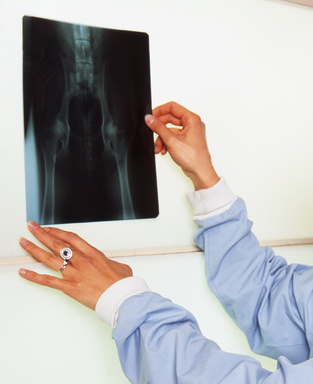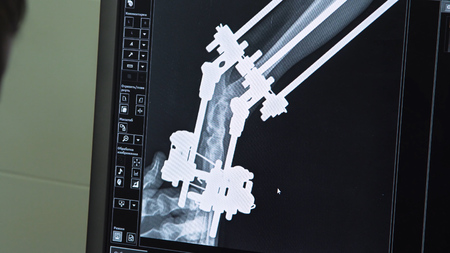
The dog's fractures

Causes
The most common causes of accidents are fractures : collision with a car or a bike, fight with another animal, fall from a window or balcony… For some dogs, shock after falling the owner's arms or a sofa can be enough to cause a fracture.
Other causes can also be responsible for fracture : it may happen that a bone weakened by a disease such as, for example, a bone tumor, even without wind there was an accident.
Symptoms
Most often, a fracture is painful. Do not try also not to touch because of intense pain reactions can lead to reflex aggression and this could make you bite.
The dog will have symptoms related to the location of the fracture :
- Boiterie or even Removal Support during fracture of the paws,
- Difficulty eating in the event of fracture at the front,
- difficulty breathing in case of ribs fractures,
- Two vous or symptoms paralysis vertebra reaching at.
- swelling, signs of trauma, is often seen : the area is swollen, takes a purplish… but be careful, these symptoms are not systematic.
- It happens that the end or ends of the broken bone tear the muscles and the skin overlying the bone lesion. The bone can then protrude outwardly. One speaks in this case “open fracture“.
- When internal lesions associated with fractures, the animal may have a State of shock : it is unable to respond, the end of its legs is cold, mucous membranes are pale and his breathing accelerated. This state is an absolute emergency and you need to contact your veterinarian as soon as possible.
Any of the aforementioned signs must, in all cases, alert you and bring you to contact your veterinarian without waiting. It can then assess the situation, diagnose and develop a treatment appropriate.

Diagnosis
Faced with symptoms suggestive of fracture, the veterinarian will start by performing a clinical exam to confirm or not his hypothesis. The symptoms described above are not, Indeed, not characteristic of a fracture and can be linked to many other diseases.
To confirm the diagnosis, X-rays of the affected part are necessary. They are generally made from several angles of view, allowing, not only, check if there are many fracture or not, but also to see how the bone is broken and how are placed the bone abouts. Treatment will depend, Indeed, the observed fracture type.

Furthermore, if your dog has suffered a trauma, the vet may need to perform various examinations such as other radiographs, a blood test or an ultrasound to check that no other lesion is present. Some internal lesions can be much more serious and therefore more urgent to treat the fracture itself.
Treatment and prognosis
In the event of an accident, prognosis depends of course on the general condition of the dog. If the trauma was important and that the dog is in shock, the first 48 hours are often decisive. In this case, veterinary standby, in first place, to stabilize the general condition of the dog. It can then be given to treat the actual fracture. Indeed, a dog whose condition is not stable and that the prognosis could be committed can not undergo immediate intervention necessary to treat his fracture. This phase of stabilization may require hospitalization to the veterinary clinic. The treatment of the fracture can then be considered.
This treatment depends on the type of fracture observed. There are incomplete fractures (the bone is only partially broken and is called crack), complete fracture (the bone is broken into two fragments) with or without displacement, complex fractures (the fracture is composed of several fragments, the bone fragments are moved or the fracture is located in a bad location) and open fractures we mentioned above.
The general principle, for a bone can heal, is to restore as much as possible pieces of bone to their original position and lock them in this position.
This immobilization is achieved by different methods depending on the type and location of the fracture. In some cases, a simple immobilization by a bandage reinforced and / or splint is possible, especially if the fracture is not displaced. But other types of fractures will require surgery with implantation of a material that will allow to properly reposition the bones and then hold them in place. These can be pins, plates, screw, nails or external fixators. Your veterinarian will most likely choose the best mode of treatment based on fracture.

Control X-rays are performed over time to monitor bone healing.
In rare cases, amputation may be recommended, especially for certain complex fractures of fingers or legs that may not heal properly. This may also be the case for some tail fractures that are virtually impossible to immobilize and can be very painful.
An associated medication therapy for the treatment of the fracture is generally prescribed : anti-inflammatory, painkillers, antibiotic optionally.
§
Fortunately, Most fractures can heal quite correctly and dogs are even sometimes surprising in their resilience ! On the other hand, appropriate treatment is essential for proper healing and will minimize the risk of sequelae. so consult your veterinarian in doubt (any fracture is not necessarily associated with high pain…), and, if a fracture is diagnosed, discuss with him possible treatment options.
Author : Dr. Helen Blondel. Illustrator : Dr. Caroline Allard – Vetup®
